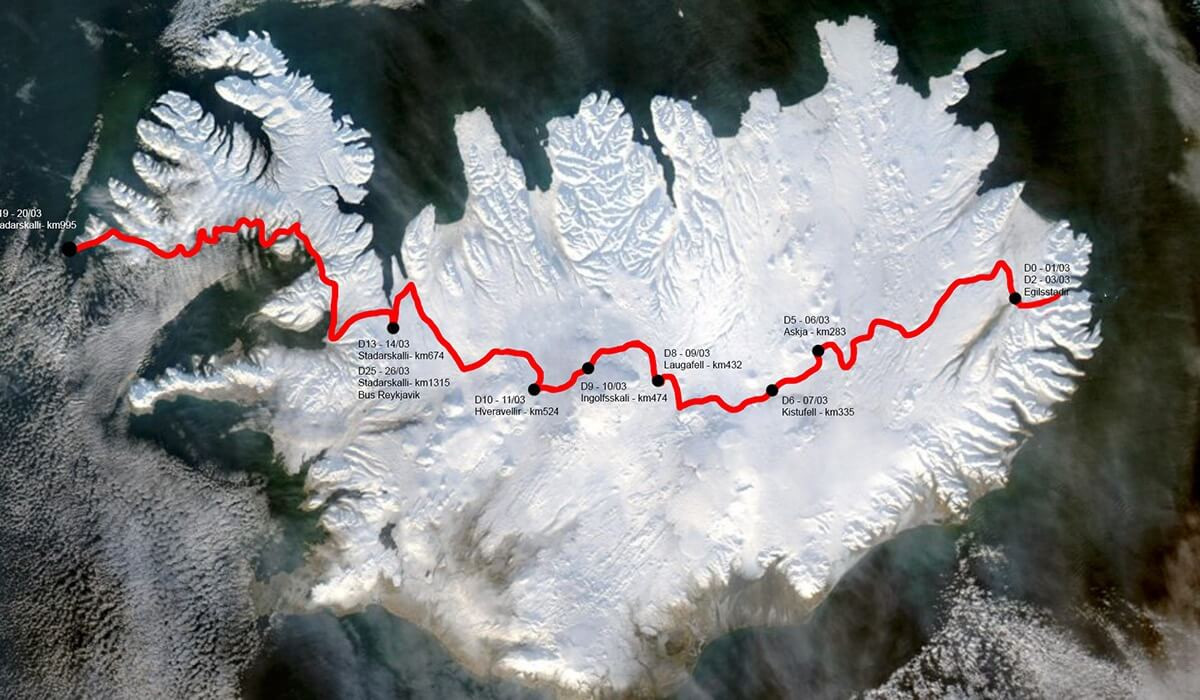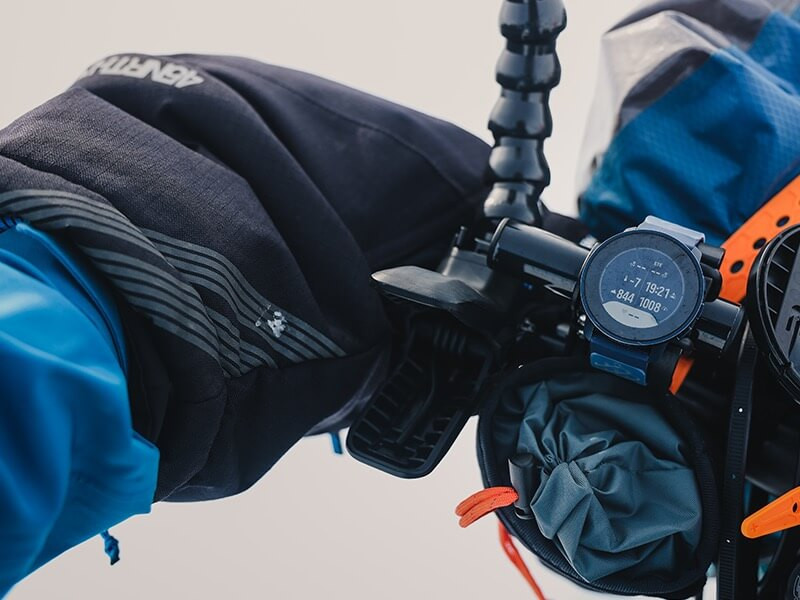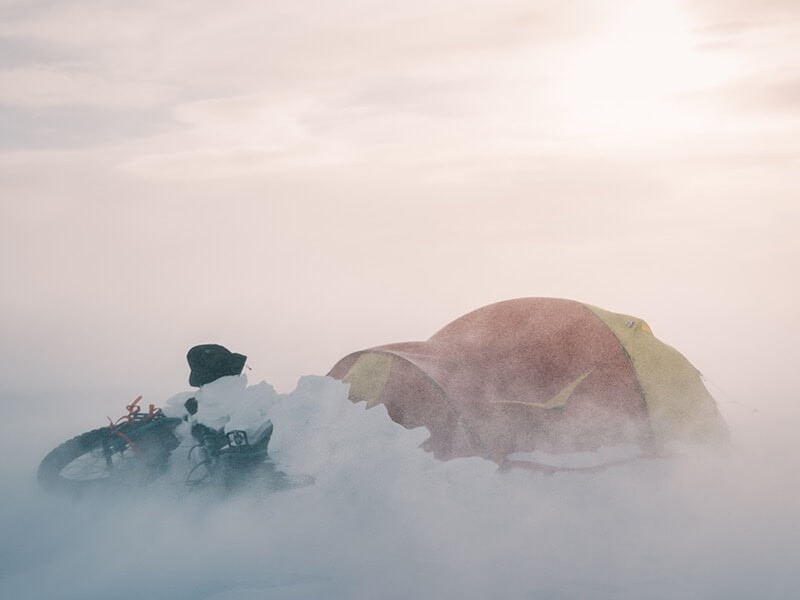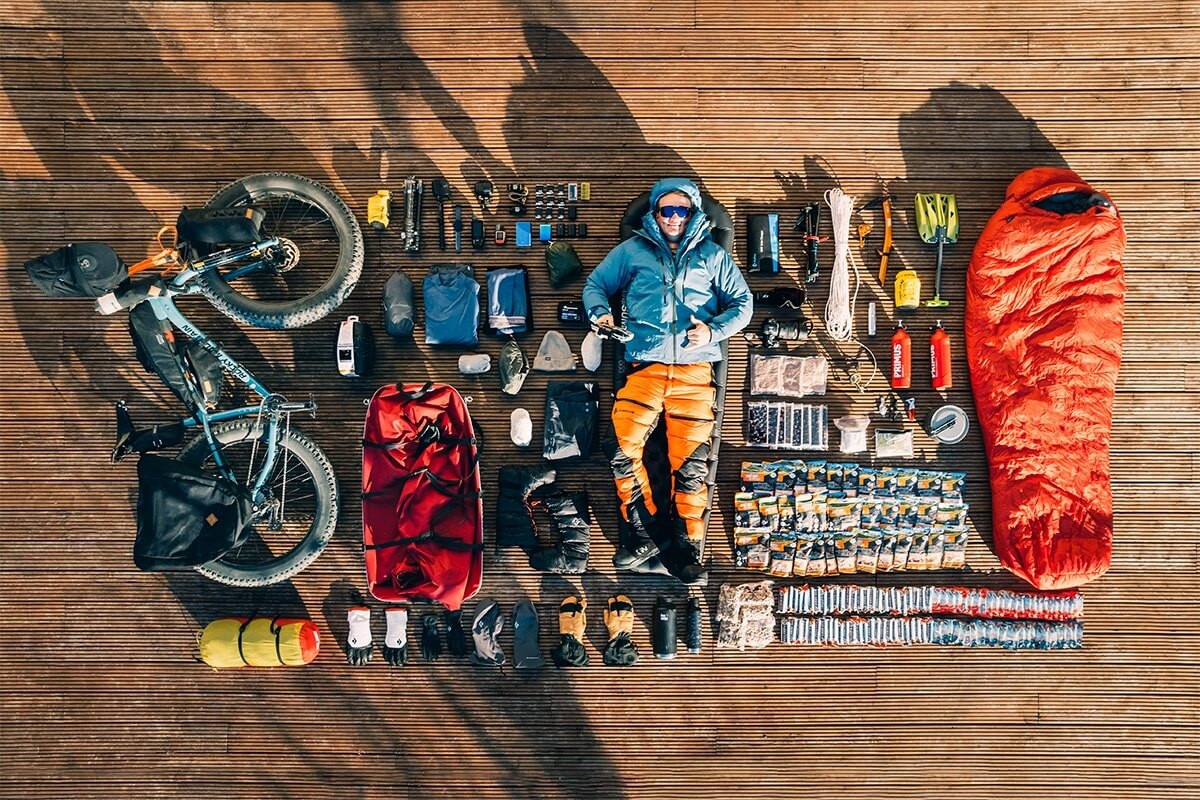28 Days Across Iceland: Joffrey’s Winter Bikepacking Epic
Posted on: 10/27/23
Last modified: 11/01/23

In March 2023, Joffrey Maluski set out to ride across Iceland from Seydisfjordur in the east to Bjargtangar in the west.
Two factors made this trip especially challenging: Joffrey chose to ride the more-rugged highland route and chose to do so during the brutal winter season. Pedaling against tent-ripping winds and temperatures far below 0, he completed the grueling ride in 28 days.
A journey like this takes knowledge, courage, and quality gear. We spoke with Joffrey about his Iceland experience, his kit, and more. Read on for his thoughts and a look at his full winter bikepacking gear list.

What was the most valuable piece of gear on this trip?
I'd say my stove, it allowed me to melt snow, enabling me to have a source of drinking water from melted snow and prepare hot meals. However, I invested a significant amount of time working on my equipment and preparation, and each piece of gear I brought proved to be useful. From 45NRTH, I had a great experience with the Wølfgar boots. They were comfortable, warm, and the option to remove the inner shoes to keep them warm in your sleeping bag during the night was truly amazing. Also, the Dillinger 5 studded tires were mandatory on ice.


If you were to repeat the trip, is there anything you would leave at home? Is there anything different you would bring?
I brought an ice pick and a rope to secure myself and/or the bike in case of a significant river crossing. However, due to the -21°C temperatures over ten days, the major rivers I would have had to cross were frozen. I still had two smaller river crossings at the beginning and end of the highlands. The ice pick was useful for getting out of the river, but I didn't end up using the rope at all during the entire trip. If I were to do it again, I'd opt for a small and lightweight pair of shoe spikes, a couple of ice screws to secure my tent on ice, and still probably keep the rope.
“Both cold and wind can pose substantial challenges, but I've found that with the right clothing, gear, and precautions, cold conditions are more easily manageable.”
What was your longest stretch without resupply? How did you prepare for that?
The entire trip lasted 28 days and covered a distance of 913 kilometers. I spent 20 days and covered 500 kilometers in the highlands without resupply. At the start of the trip, I carried 25 days of food, which amounted to 21kg, along with an additional 3kg of fuel for the stove. My daily meals were as follows:
- Morning: 1 cup of hot chocolate, 1 dried meal with extra olive oil.
- Throughout the day: 4 Clif Bars and 50 grams of nuts.
- Dinner: 1 soup, 1 dried meal with extra olive oil and chocolate.
- Additionally, I had to supplement my water with electrolytes because melted snow lacks the minerals needed for proper hydration.



What was more challenging: the cold or the wind?
Both cold and wind can pose substantial challenges, but I've found that with the right clothing, gear, and precautions, cold conditions are more easily manageable. However, in the face of heavy wind, there's often little one can do, and the wind's effect on feeling temperatures can drop to dangerous levels. Towards the end of my journey through the highlands, I encountered a wind storm with gusts reaching 140-150 kilometers per hour. I had to take shelter in my tent for safety, and I ended up staying in there for two days.



What was your layering strategy on most days?
For most of the day, I wore only a merino base layer and my goretex, even on the -21°C days. I aimed to avoid taking long breaks and maintained my effort to stay warm without sweating. At the end of the day, I added my down jacket, down pants, and down boots for extra insulation and a cosy evening in the tent.

You’ve also ridden across Iceland in the summer. Which did you prefer?
It's pretty hard to choose, but if I had to pick a favorite, it would be the summer trip in Iceland that I took with my friends, Léo-Paul and Katia, in 2021. Traveling with close friends made this trip truly memorable. One of the main draws of this trip was the opportunity to explore the breathtaking highlands of Iceland that we crossed from north to south and east to west.
However, I must admit that I also cherish the solitude of being by myself amidst the vast glaciers and harsh conditions of the Icelandic winter. Both experiences have their unique appeal and have enriched my life in different ways, but the camaraderie and shared moments with friends during the summer trip hold a special place in my heart.
"Above all, bikepacking adventures always come with ups and downs, both physically and mentally. So in these moments, it’s important to remember why you are here, that the essence of adventure is the journey itself."
Did you learn anything new on this journey?
I’ve previously embarked on solo travels in challenging conditions, but none were as demanding and immersive as this winter crossing of Iceland. This experience has provided me with invaluable insights into managing myself during physically and mentally challenging moments.It pushed me to my limits, testing my resilience and resourcefulness. I learned to adapt to the harsh weather conditions and cope with the isolation of remote landscapes. The physical demands of the journey taught me the importance of endurance and proper gear, while the mental challenges reinforced the importance of staying focused and maintaining a positive outlook.




What packing advice would you give to people thinking about taking on longer or more difficult rides like this?
Do thorough research, plan your journey, and have a clear idea of the route and available resources along the way. Invest in the right gear you can trust in any conditions and a bike designed for adventure riding. Learn how to perform basic maintenance on your bike, as well as for your tent, stove, or other gear. Work on your fitness and endurance, practice on different terrains, and gradually increase your distance and difficulty.
All of these allow you to embark on a challenging adventure with more confidence. But above all, bikepacking adventures always come with ups and downs, both physically and mentally. So in these moments, it’s important to remember why you are here, that the essence of adventure is the journey itself. Take the time to soak in the beauty of your surroundings, appreciate the unique experience, and relish the sense of accomplishment. A warm smile always helps you get through a difficult moment. :)


Gear List
This trip involved a pretty extensive winter bikepacking gear list. What did you bring?
- Bike: Rocky Mountain Blizzard Allow
- Racks: Old Man Mountain Divide Fat and Elkorn
- Straps: Fixplus
- Packs: Restrap
- Saddle: Brooks B17
- Tires: 45NRTH Dillinger 5 (27.5x4.5”)
- Boots: 45NRTH Wølfgar
- Pogies: 45NRTH Cobrafist
- GPS watch: Suunto 9 Peak Pro
- Sleeping bag: Helsport Svalbard -29°C
- Sleeping mat: Sea to Summit Ether Light XT
- Tent: Helsport Lofoten X-trem 3 Camp
- Sunglass: Julbo Ultimate 2-4 & Goggles 0-4
- Helmet: Smith Forefront 2
- Headlamp: Golum Piom 2 x2
- Clothing: Patagonia
- Base layers: Thermowave
- Down pants and boots: Cumulus
- Outdoor Gloves: 45NRTH Sturmfist 4 LTR & Black Diamond Guide
- Stove: Primus Omnilite Ti (3L of fuel)
- Pot: Sea to Summit 2.7L
- Food: 25 days of MX3 Nutrition dried meals, Clif Bars, nuts, chocolate, soup, electrolytes
- Thermos: Klean Kanteen 2L + 0.6L
- Camera: Canon R6, RF 24-105 F4. GoPro Max & Hero 11
- SD card: PNY Technologies
- Tripod: Benrofrance Rhino Drone: Dji Mini 3 Pro
- Powerbank: Zendure 27ah + 10ah
- Solar panels: Big Blue 28w
- Satellite communication: Garmin Inreach Mini 2 + GPSMAP 66i
- Pulka: Acapulka Tour 100
- Poles: Black Diamond Distance Carbon Z
- Ice pick: Petzl Gully 20m rope, two carabiners, Micro Traxion: Petzl

Planning Your Own Deep-Winter Rides This Year?
Shop the expedition-tested gear Joffrey used for his Icelandic epic:

Sturmfist 4 LTR

Dillinger 5 Tire


